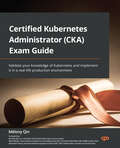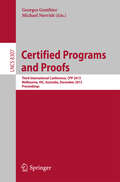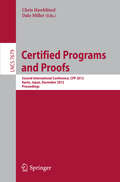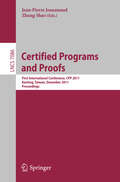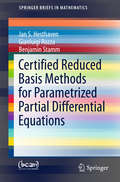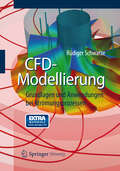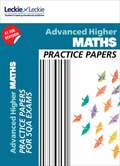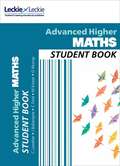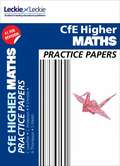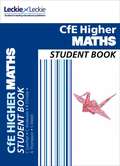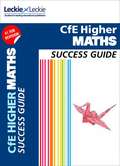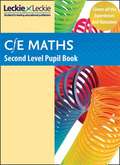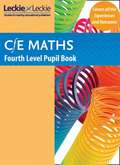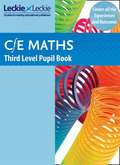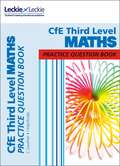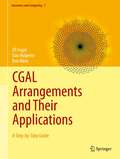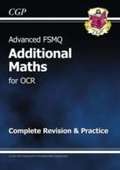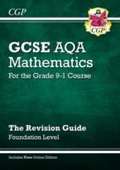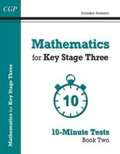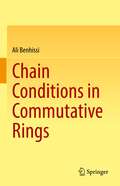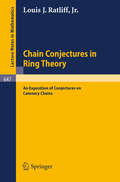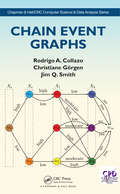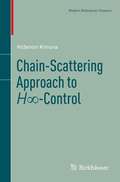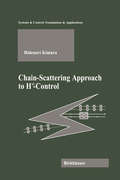- Table View
- List View
Certified Kubernetes Administrator (cka) Exam Guide: Validate Your Knowledge Of Kubernetes And Implement It In A Real-life Production Environment
by Brendan Burns Melony Qin Mark Whitby Alessandro VozzaValidate your knowledge of Kubernetes and implement it in a real-life production environment
Certified Programs and Proofs: Third International Conference, CPP 2013, Melbourne, VIC, Australia, December 11-13,2013, Proceedings (Lecture Notes in Computer Science #8307)
by Georges Gonthier Michael NorrishThis book constitutes the refereed proceedings of the Third International Conference on Certified Programs and Proofs, CPP 2013, colocated with APLAS 2013 held in Melbourne, Australia, in December 2013. The 18 revised regular papers presented together with 1 invited lecture were carefully reviewed and selected from 39 submissions. The papers are organized in topical sections on code verification, elegant proofs, proof libraries, certified transformations and security.
Certified Programs and Proofs: Second International Conference, CPP 2012, Kyoto, Japan, December 13-15, 2012, Proceedings (Lecture Notes in Computer Science #7679)
by Chris Hawblitzel Dale MillerThis book constitutes the refereed proceedings of the Second International Conference on Certified Programs and Proofs, CPP 2012, held in Kyoto, Japan, in December 2012. The 18 revised regular papers presented were carefully reviewed and selected from 37 submissions. They deal with those topics in computer science and mathematics in which certification via formal techniques is crucial.
Certified Programs and Proofs: First International Conference, CPP 2011, Kenting, Taiwan, December 7-9, 2011, Proceedings (Lecture Notes in Computer Science #7086)
by Jean-Pierre Jouannaud Zhong ShaoThis book constitutes the referred proceedings of the First International Conference on Certified Programs and Proofs, CPP 2011, held in Kenting, Taiwan, in December 2011. The 24 revised regular papers presented together with 4 invited talks were carefully reviewed and selected from 49 submissions. They are organized in topical sections on logic and types, certificates, formalization, proof assistants, teaching, programming languages, hardware certification, miscellaneous, and proof perls.
Certified Reduced Basis Methods for Parametrized Partial Differential Equations (SpringerBriefs in Mathematics)
by Jan S Hesthaven Gianluigi Rozza Benjamin StammThis book provides a thorough introduction to the mathematical and algorithmic aspects of certified reduced basis methods for parametrized partial differential equations. Central aspects ranging from model construction, error estimation and computational efficiency to empirical interpolation methods are discussed in detail for coercive problems. More advanced aspects associated with time-dependent problems, non-compliant and non-coercive problems and applications with geometric variation are also discussed as examples.
CFD-Modellierung: Grundlagen und Anwendungen bei Strömungsprozessen
by Rüdiger SchwarzeIn diesem kompakten Lehrbuch legt der Autor die Methodik der numerischen Simulation von Strömungsprozessen dar. Nach einer konzisen Erläuterung der Grundlagen lernen Leser das Potenzial der Methodik anhand von Anwendungsbeispielen kennen. Demonstriert werden sowohl einfache wie komplexe Probleme. Während Leser die einfachen Problemstellungen mithilfe von Open-Source-Softwarepaketen selbst bearbeitet können, sind die komplexen Beispiele aus aktuellen grundlagenorientierten und aus anwendungsnahen Forschungsprojekten des Autors abgeleitet.
Cfe Advanced Higher Maths Practice Papers For Sqa Exams (Practice Papers For Sqa Exam Revision Ser.)
by Leckie and Leckie and Leckie Craig Lowther Dominic Kennedy Graeme NolanExam Board: SQA Level: Advanced Higher Subject: Maths First Teaching: 2015, First Exam: 2016 Get ready for your CfE Advanced Higher Maths exam with these brand new practice papers that look just like the SQA exam - the best way to prepare for the big day! Get ready for your CfE Advanced Higher Maths exam with these brand new practice papers that look just like the SQA exam - the best way to prepare for the big day! Give yourself the best chance to excel with these original and full practice papers Build your confidence with the type and level of questions you can expect in your SQA exam Detailed answers to all of the questions show you exactly how your exam will be marked Hints and tips throughout explain how to approach different types of question A topic index shows you where to find questions for any areas you'd like to practise specifically
Cfe Advanced Higher Maths Student Book (PDF)
by Anita Leckie Clare Ford Craig Lowther Deirdre Murray John Ballantyne Monica KirsonExam Board: SQA Level: Higher Subject: Maths First Teaching: 2015, First Exam: 2016 The Advanced Higher Maths Student Book helps teachers and students map their route through the CfE programme, providing comprehensive and authoritative guidance for the course. Full coverage of the new Advanced Higher course specifications with list of learning intentions Attractive layout with clear text features Key questions highlight crucial concepts and techniques that need to be grasped by students in order to progress to the next learning intention What the examiner/assessor is looking for to help teachers & students feel secure End of unit material - unit assessment, exam-style questions with worked answers and examiners commentary, self-assessment Student Books give a practical, supportive approach to help deliver the new curriculum and offer a blend of sound teaching and learning with assessment guidance.
CfE Higher Mathematics Practice Papers for SQA Exams (Practice Papers for SQA Exams) (PDF)
by Leckie And LeckieThis book contains practice exam papers, which mirror the actual SQA exam as much as possibl.
CfE Higher Maths Student Book (PDF)
by Andrew Thompson Craig Lowther Stuart Welsh Claire Anderson Robin ChristieThe Higher Maths Student Book helps teachers and students map their route through the CfE programme, providing comprehensive and authoritative guidance for the course.
CfE Higher Maths Success Guide (Success Guide) (PDF)
by Ken NisbetPrepare to excel in your CfE Higher SQA exam with this Success Guide - the first choice for Scottish students! Success Guides really work because: Topics in user-friendly sections help plan revision Examples throughout explain new ideas clearly Quick Tests provide the practice that experts say is required for recall.
CfE Maths: Second Level Pupil Book (PDF)
by Brian Speed Trevor Senior Jeanette Mumford Keith Gordon Kevin EvansThe Curriculum for Excellence Maths Second Level Pupil Book is packed with questions and activities to improve performance across all of the Outcomes and Experiences at Second Level.
CfE Maths Fourth Level Pupil Book (PDF)
by Ian Macandie Craig Lowther Robin Christie Claire CrossmanThe CfE Maths series covers all the Experiences and Outcomes within the Scottish Curriculum for Excellence for Maths at Second, Third and Fourth Levels. Separate pupil books at each level offer a flexible pathway through the curriculum.
CfE Maths Third Level Pupil Book (PDF)
by Brian Speed Ian Macandie Trevor Senior Keith Gordon Craig Lowther Kevin Evans John Boath Robin Christie Claire CrossmanThe CfE Maths Third Level Pupil Book is packed with questions and activities to improve performance across all of the Outcomes and Experiences at Third Level.
CfE Third Level Maths Practice Question Book (SQA Practice Question Book Ser.)
by Craig Lowther Ian MacAndie Leckie and Leckie StaffExam Board: SQA Level: Higher Subject: Maths First Teaching: 2014, First Exam: 2015 Masses of practice questions for every topic on the curriculum. Essential extra questions for every topic on the curriculum, to reinforce learning and build exam confidence. It can be used either alongside the N5 Maths Student Book or as a flexible standalone resource – for homework, independent study or exam practice. Included in this book: • Questions for every topic on the curriculum, with more of the tricky ones • Example answers with workings-out help explain difficult concepts • Hints and tips throughout give practical advice about the different kinds of question Answers can be downloaded from www.collins.co.uk/pages/scottish-curriculum-free-resources.
CGAL Arrangements and Their Applications: A Step-by-Step Guide (Geometry and Computing #7)
by Efi Fogel Dan Halperin Ron WeinArrangements of curves constitute fundamental structures that have been intensively studied in computational geometry. Arrangements have numerous applications in a wide range of areas – examples include geographic information systems, robot motion planning, statistics, computer-assisted surgery and molecular biology. Implementing robust algorithms for arrangements is a notoriously difficult task, and the CGAL arrangements package is the first robust, comprehensive, generic and efficient implementation of data structures and algorithms for arrangements of curves. This book is about how to use CGAL two-dimensional arrangements to solve problems. The authors first demonstrate the features of the arrangement package and related packages using small example programs. They then describe applications, i.e., complete standalone programs written on top of CGAL arrangements used to solve meaningful problems – for example, finding the minimum-area triangle defined by a set of points, planning the motion of a polygon translating among polygons in the plane, computing the offset polygon, finding the largest common point sets under approximate congruence, constructing the farthest-point Voronoi diagram, coordinating the motion of two discs moving among obstacles in the plane, and performing Boolean operations on curved polygons. The book contains comprehensive explanations of the solution programs, many illustrations, and detailed notes on further reading, and it is supported by a website that contains downloadable software and exercises. It will be suitable for graduate students and researchers involved in applied research in computational geometry, and for professionals who require worked-out solutions to real-life geometric problems. It is assumed that the reader is familiar with the C++ programming-language and with the basics of the generic-programming paradigm.
CGP Advanced FSMQ Additional Mathematics for OCR: Complete Revision and Practice (PDF)
by Coordination Group PublicationsAdvanced FSMQ: Additional Mathematics for OCR - Complete Revision and Practice
CGP GCSE AQA Mathematics for the Grade 9-1 Course: The Revision Guide - Foundation Level
by Cgp BooksThis new edition of CGP's Foundation Level AQA GCSE Maths Revision Guide is bang-up-to-date for the latest 'Grade 9-1' course! It's packed with concise, friendly explanations of every topic, backed up with plenty of step-by-step examples. Grade information (on the new 9-1 scale) is included to show the difficulty level of each topic, and there are exam-style questions at the bottom of each page to test you on the important skills. And finally, a unique code is printed in the book that gives you access to the free Online Edition of the whole book on your PC, Mac or tablet! For even more help with this course, don't forget CGP's matching Workbook (9781782943921) and Exam Practice Workbook (9781782943907).
CGP Mathematics for Key Stage 3: 10-Minute Tests, Book 2 (PDF)
by CgpThis is Book Two in CGP's range of three 10-Minute Tests books - it covers all the medium-difficulty material from KS3 Maths. Inside, you'll find over 30 bite-sized tests, each packed with questions on a mixture of topics. Complete answers and mark schemes are included at the back, so it's easy to find out how well students are progressing.
Chain Conditions in Commutative Rings
by Ali BenhissiThis book gathers, in a beautifully structured way, recent findings on chain conditions in commutative algebra that were previously only available in papers. The majority of chapters are self-contained, and all include detailed proofs, a wealth of examples and solved exercises, and a complete reference list. The topics covered include S-Noetherian, S-Artinian, Nonnil-Noetherian, and Strongly Hopfian properties on commutative rings and their transfer to extensions such as polynomial and power series rings, and more. Though primarily intended for readers with a background in commutative rings, modules, polynomials and power series extension rings, the book can also be used as a reference guide to support graduate-level algebra courses, or as a starting point for further research.
Chain Conjectures in Ring Theory: An Exposition of Conjectures on Catenary Chains (Lecture Notes in Mathematics #647)
by L.J. Jr. RatliffChain Event Graphs (Chapman & Hall/CRC Computer Science & Data Analysis)
by Rodrigo A. Collazo Christiane Goergen Jim Q. SmithWritten by some major contributors to the development of this class of graphical models, Chain Event Graphs introduces a viable and straightforward new tool for statistical inference, model selection and learning techniques. The book extends established technologies used in the study of discrete Bayesian Networks so that they apply in a much more general setting As the first book on Chain Event Graphs, this monograph is expected to become a landmark work on the use of event trees and coloured probability trees in statistics, and to lead to the increased use of such tree models to describe hypotheses about how events might unfold. Features: introduces a new and exciting discrete graphical model based on an event tree focusses on illustrating inferential techniques, making its methodology accessible to a very broad audience and, most importantly, to practitioners illustrated by a wide range of examples, encompassing important present and future applications includes exercises to test comprehension and can easily be used as a course book introduces relevant software packages Rodrigo A. Collazo is a methodological and computational statistician based at the Naval Systems Analysis Centre (CASNAV) in Rio de Janeiro, Brazil. Christiane Görgen is a mathematical statistician at the Max Planck Institute for Mathematics in the Sciences, Leipzig, Germany. Jim Q. Smith is a professor of statistics at the University of Warwick, UK. He has published widely in the field of statistics, AI, and decision analysis and has written two other books, most recently Bayesian Decision Analysis: Principles and Practice (Cambridge University Press 2010).
Chain Event Graphs (Chapman & Hall/CRC Computer Science & Data Analysis)
by Rodrigo A. Collazo Christiane Goergen Jim Q. SmithWritten by some major contributors to the development of this class of graphical models, Chain Event Graphs introduces a viable and straightforward new tool for statistical inference, model selection and learning techniques. The book extends established technologies used in the study of discrete Bayesian Networks so that they apply in a much more general setting As the first book on Chain Event Graphs, this monograph is expected to become a landmark work on the use of event trees and coloured probability trees in statistics, and to lead to the increased use of such tree models to describe hypotheses about how events might unfold. Features: introduces a new and exciting discrete graphical model based on an event tree focusses on illustrating inferential techniques, making its methodology accessible to a very broad audience and, most importantly, to practitioners illustrated by a wide range of examples, encompassing important present and future applications includes exercises to test comprehension and can easily be used as a course book introduces relevant software packages Rodrigo A. Collazo is a methodological and computational statistician based at the Naval Systems Analysis Centre (CASNAV) in Rio de Janeiro, Brazil. Christiane Görgen is a mathematical statistician at the Max Planck Institute for Mathematics in the Sciences, Leipzig, Germany. Jim Q. Smith is a professor of statistics at the University of Warwick, UK. He has published widely in the field of statistics, AI, and decision analysis and has written two other books, most recently Bayesian Decision Analysis: Principles and Practice (Cambridge University Press 2010).
Chain-Scattering Approach to H∞-Control (Modern Birkhäuser Classics)
by Hidenori KimuraThe advent of H∞-control was a truly remarkable innovation in multivariable theory. It eliminated the classical/modern dichotomy that had been a major source of the long-standing skepticism about the applicability of modern control theory, by amalgamating the "philosophy" of classical design with "computation" based on the state-space problem setting. It enhanced the application by deepening the theory mathematically and logically, not by weakening it as was done by the reformers of modern control theory in the early 1970s. The purpose of this book is to provide a natural theoretical framework that is understandable with little mathematical background. The notion of chain-scattering, well known in classical circuit theory, but new to control theorists, plays a fundamental role in this book. It captures an essential feature of the control systems design, reducing it to a J-lossless factorization, which leads naturally to the idea of H-infinity-control. The J-lossless conjugation, an essentially new notion in linear system theory, then provides a powerful tool for computing this factorization. Thus the chain-scattering representation, the J-lossless factorization, and the J-lossless conjugation are the three key notions that provide the thread of development in this book. The book is completely self contained and requires little mathematical background other than some familiarity with linear algebra. It will be useful to applied mathematicians and practicing engineers in control system design and as a text for a graduate course in H∞-control and its applications.
Chain-Scattering Approach to H∞Control (Systems & Control: Foundations & Applications)
by Hidenori KimuraThrough its rapid progress in the last decade, HOOcontrol became an established control technology to achieve desirable performances of con trol systems. Several highly developed software packages are now avail able to easily compute an HOOcontroller for anybody who wishes to use HOOcontrol. It is questionable, however, that theoretical implications of HOOcontrol are well understood by the majority of its users. It is true that HOOcontrol theory is harder to learn due to its intrinsic mathemat ical nature, and it may not be necessary for those who simply want to apply it to understand the whole body of the theory. In general, how ever, the more we understand the theory, the better we can use it. It is at least helpful for selecting the design options in reasonable ways to know the theoretical core of HOOcontrol. The question arises: What is the theoretical core of HOO control? I wonder whether the majority of control theorists can answer this ques tion with confidence. Some theorists may say that the interpolation theory is the true essence of HOOcontrol, whereas others may assert that unitary dilation is the fundamental underlying idea of HOOcontrol. The J spectral factorization is also well known as a framework of HOOcontrol. A substantial number of researchers may take differential game as the most salient feature of HOOcontrol, and others may assert that the Bounded Real Lemma is the most fundamental building block.
